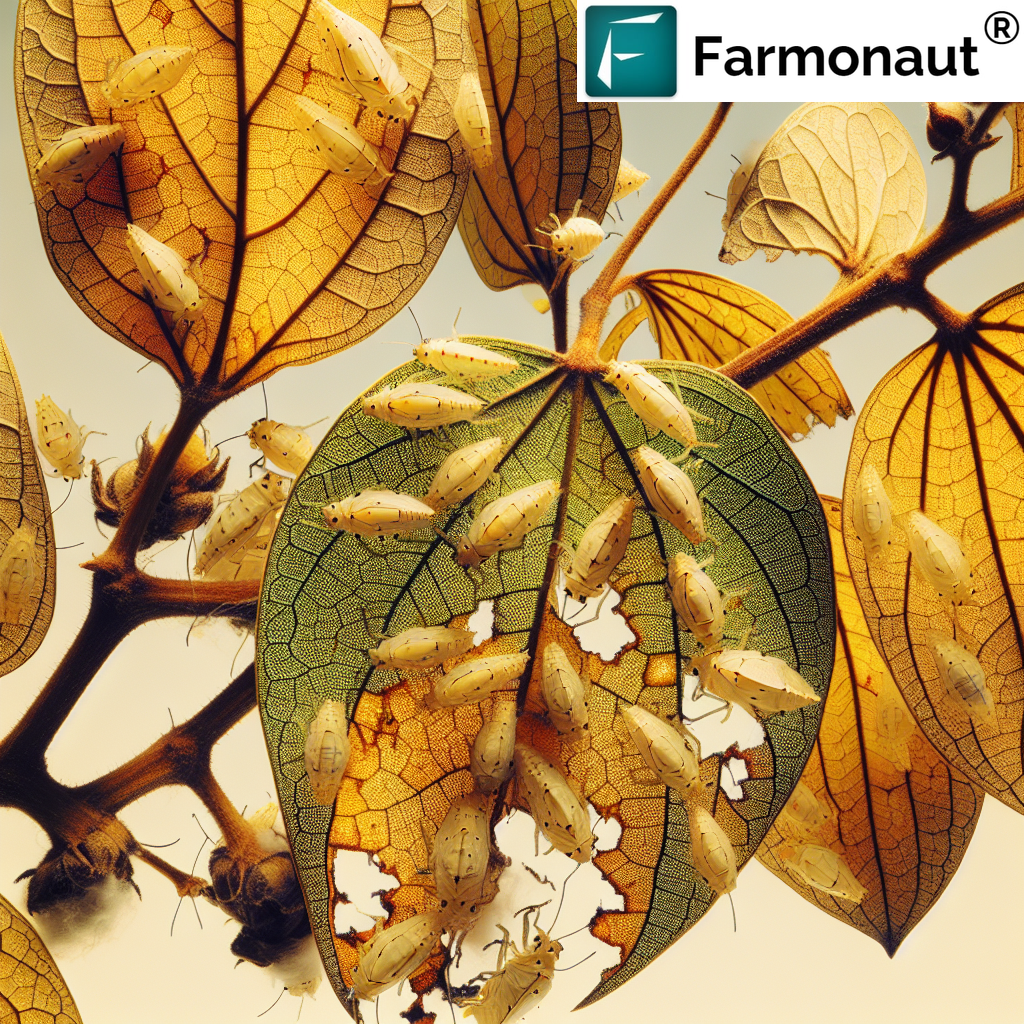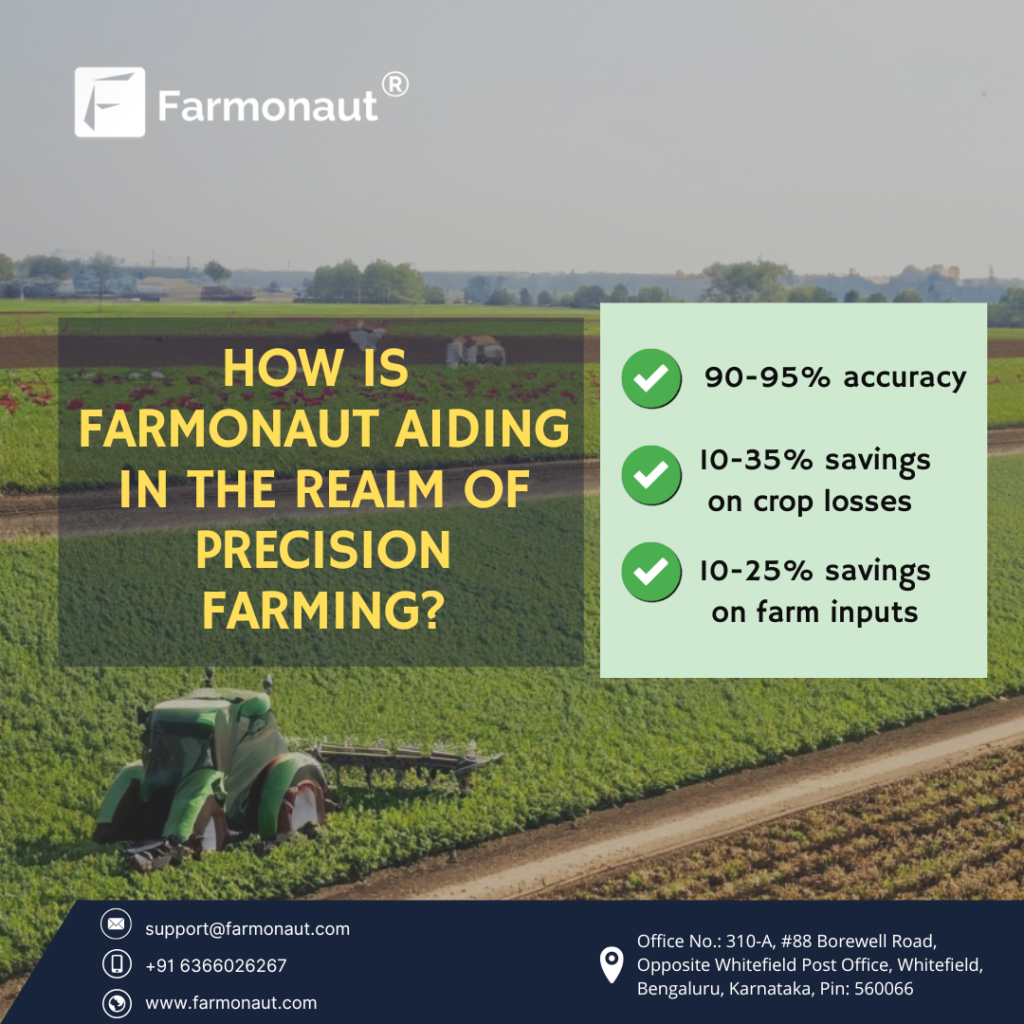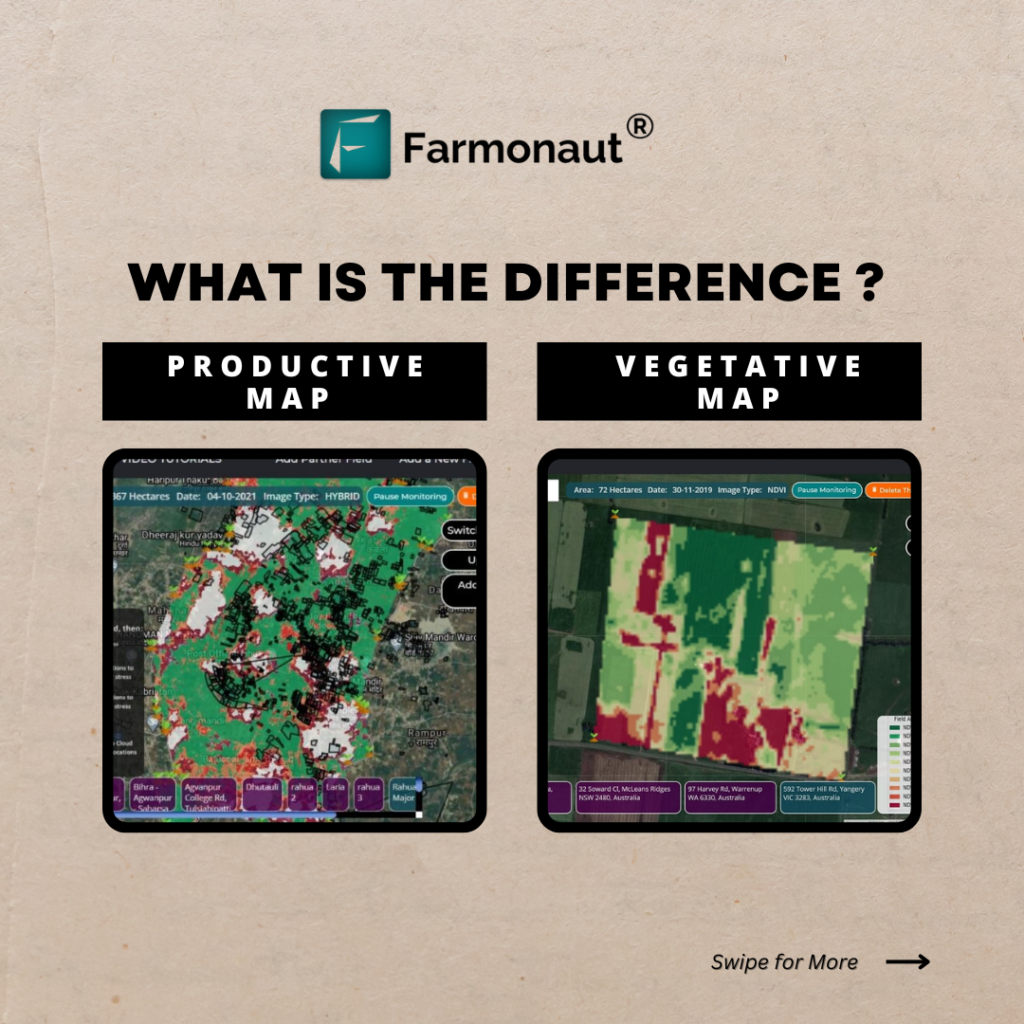
Mastering Leaf Hopper Control: Protecting Your Cotton Crop from Damage and Burn
As agricultural technology experts at Farmonaut, we understand the critical challenges farmers face in protecting their crops from pests and diseases. One of the most persistent threats to cotton crops is the leaf hopper, a small but destructive insect that can cause significant damage if left unchecked. In this comprehensive guide, we’ll explore the intricacies of leaf hopper damage, particularly in cotton crops, and provide you with effective strategies for leaf hopper control and leaf hopper treatment.
Understanding Leaf Hoppers and Their Impact on Cotton
Leaf hoppers are small, wedge-shaped insects that feed on the sap of plant leaves. In cotton fields, these pests can quickly become a major problem, leading to various forms of damage that can significantly reduce crop yield and quality. Let’s delve deeper into the specifics of cotton leaf hopper damage and its consequences.
The Nature of Leaf Hopper Damage
Leaf hopper damage in cotton plants typically manifests in several ways:
- Yellowing of leaves, particularly at the edges
- Stunted growth of plants
- Reduced photosynthesis due to leaf damage
- Decreased cotton yield and quality
- Increased susceptibility to other diseases
One of the most distinctive signs of severe infestation is leaf hopper burn. This condition occurs when the edges of cotton leaves turn brown and curl upward, resembling a burn. Leaf hopper burn is a result of the toxins injected by leaf hoppers during feeding, which disrupts the plant’s ability to transport nutrients effectively.

The Importance of Early Detection and Monitoring
At Farmonaut, we emphasize the critical role of early detection in managing pest infestations effectively. Our satellite-based crop monitoring system provides farmers with real-time insights into their field’s health, allowing for the early identification of potential leaf hopper infestations. By leveraging advanced technology, we enable farmers to take proactive measures before leaf hopper damage becomes severe.
How Farmonaut’s Satellite Monitoring Helps in Leaf Hopper Detection
Our satellite imagery analysis can detect subtle changes in crop health that may indicate the presence of leaf hoppers:
- Vegetation health index changes that might suggest early stages of infestation
- Identification of stress patterns consistent with leaf hopper damage
- Regular monitoring to track the spread and intensity of potential infestations
- AI-powered alerts to notify farmers of suspicious changes in crop health
By utilizing our Farmonaut app, farmers can access this vital information directly on their smartphones, enabling quick decision-making and timely intervention.
Effective Strategies for Leaf Hopper Control
Implementing a comprehensive leaf hopper control strategy is crucial for protecting your cotton crop. At Farmonaut, we recommend a multi-faceted approach that combines traditional methods with modern technology.
1. Cultural Control Methods
Cultural control methods focus on creating an environment that is less favorable for leaf hoppers:
- Crop rotation to disrupt the leaf hopper life cycle
- Proper irrigation management to maintain plant vigor
- Removal of weeds that may serve as alternate hosts for leaf hoppers
- Planting resistant cotton varieties when available
2. Biological Control
Encouraging natural predators can help keep leaf hopper populations in check:
- Introduction of predatory insects like ladybugs and lacewings
- Use of parasitic wasps that target leaf hopper eggs
- Creating habitat for beneficial insects near cotton fields
3. Chemical Control
When necessary, chemical control can be an effective part of a leaf hopper treatment plan:
- Use of systemic insecticides for severe infestations
- Application of neem-based products for organic farming
- Targeted spraying based on infestation levels detected through monitoring
It’s important to note that the use of chemical controls should be done judiciously and in compliance with local regulations. Our Farmonaut system can help optimize the timing and application of these treatments for maximum effectiveness and minimal environmental impact.
4. Integrated Pest Management (IPM)
We strongly advocate for an Integrated Pest Management approach, which combines various control methods:
- Regular field scouting and monitoring
- Use of economic thresholds to determine when control measures are necessary
- Combination of cultural, biological, and chemical control methods
- Continuous evaluation and adjustment of management strategies
Leveraging Technology for Advanced Leaf Hopper Management
At Farmonaut, we’re at the forefront of integrating cutting-edge technology into agricultural practices. Our satellite-based monitoring system offers several advantages over traditional methods:
| Feature | Farmonaut Satellite System | Drone-based Monitoring | IoT-based Monitoring |
|---|---|---|---|
| Coverage Area | Large scale (entire farms) | Limited by flight time and regulations | Limited by sensor placement |
| Frequency of Data Collection | Daily to weekly | As needed, weather-dependent | Continuous, but localized |
| Cost-effectiveness | High (no equipment needed on-site) | Moderate (requires drone purchase/operation) | Variable (depends on number of sensors) |
| Data Analysis | AI-powered, comprehensive | Requires separate analysis tools | Often limited to specific parameters |
| Ease of Use | User-friendly app interface | Requires skilled operator | Requires technical setup and maintenance |
By utilizing our satellite-based system, farmers can gain a comprehensive view of their entire cotton field, enabling them to spot potential leaf hopper damage early and implement targeted control measures efficiently.
The Role of Weather in Leaf Hopper Management
Weather conditions play a crucial role in leaf hopper populations and the effectiveness of control measures. Our Farmonaut Weather API provides accurate, localized weather forecasts that can help farmers plan their leaf hopper control strategies more effectively:
- Predicting periods of high leaf hopper activity based on temperature and humidity
- Optimizing the timing of insecticide applications to avoid wash-off by rain
- Planning cultural control measures around favorable weather conditions
Implementing a Comprehensive Leaf Hopper Treatment Plan
A successful leaf hopper treatment plan requires a systematic approach. Here’s a step-by-step guide to implementing an effective strategy:
- Regular Monitoring: Use Farmonaut’s satellite monitoring to keep a close eye on your cotton fields. Our app is available for both Android and iOS devices.
- Early Detection: Identify signs of leaf hopper damage as early as possible.
- Assess Infestation Levels: Determine the extent of the infestation using our AI-powered analysis tools.
- Choose Appropriate Control Methods: Select a combination of cultural, biological, and chemical controls based on the infestation level and crop stage.
- Implement Controls: Apply the chosen control methods, ensuring proper timing and application techniques.
- Monitor Effectiveness: Continue to use Farmonaut’s monitoring tools to assess the effectiveness of your control measures.
- Adjust as Needed: Based on the results, adjust your strategy for ongoing protection against leaf hoppers.
The Economic Impact of Effective Leaf Hopper Management
Implementing a robust leaf hopper control strategy can have significant economic benefits for cotton farmers:
- Increased crop yields due to reduced leaf hopper damage
- Improved cotton quality, potentially commanding higher market prices
- Reduced expenditure on pesticides through targeted and efficient application
- Long-term soil health improvements from reduced chemical usage
By leveraging Farmonaut’s technology, farmers can maximize these economic benefits while minimizing the environmental impact of their pest control efforts.
Future Trends in Leaf Hopper Control
As we look to the future, several emerging trends promise to revolutionize leaf hopper control in cotton farming:
- Advanced AI algorithms for even earlier detection of potential infestations
- Integration of climate change models to predict long-term pest pressure
- Development of new, environmentally friendly biopesticides
- Precision agriculture techniques for ultra-targeted pest control measures
At Farmonaut, we’re committed to staying at the forefront of these advancements, continually improving our services to provide farmers with the most effective tools for crop protection.
Conclusion: Empowering Farmers in the Fight Against Leaf Hoppers
Effective management of leaf hoppers in cotton crops requires a combination of vigilance, knowledge, and the right tools. By understanding the nature of leaf hopper damage, implementing comprehensive control strategies, and leveraging advanced technologies like Farmonaut’s satellite monitoring system, farmers can protect their cotton crops and ensure healthy, productive harvests.
We invite you to explore how Farmonaut can revolutionize your approach to pest management and overall farm productivity. Visit our website or download our app to start your journey towards more efficient, data-driven farming practices.
FAQ Section
Q: What are the first signs of leaf hopper damage in cotton?
A: Early signs include yellowing of leaf edges, small triangular brown spots on leaves, and stunted plant growth.
Q: How often should I monitor my cotton fields for leaf hoppers?
A: We recommend daily monitoring during peak seasons using Farmonaut’s satellite imagery analysis for comprehensive coverage.
Q: Can leaf hopper damage be reversed?
A: While severe damage can’t be reversed, early detection and prompt treatment can prevent further damage and allow the plant to recover.
Q: Are there any natural predators of leaf hoppers?
A: Yes, ladybugs, lacewings, and certain species of parasitic wasps are natural predators of leaf hoppers.
Q: How does Farmonaut’s technology help in leaf hopper control?
A: Our satellite monitoring system provides early detection of potential infestations, allowing for timely and targeted interventions.
Subscribe to Farmonaut
Ready to take your farm management to the next level? Subscribe to Farmonaut’s services and gain access to cutting-edge satellite monitoring, AI-powered insights, and expert agricultural advice.
By subscribing, you’ll join a community of forward-thinking farmers committed to sustainable and efficient agricultural practices. Don’t let leaf hoppers or any other pests threaten your cotton crop. Empower your farm management with Farmonaut today!












